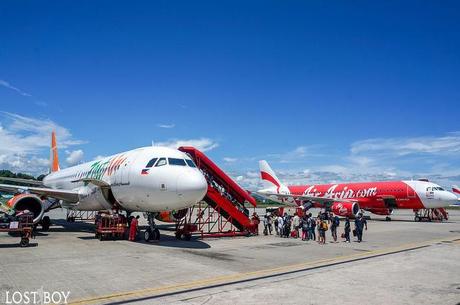What used to be called ZestAir dropped its orange and green colors in favor of red and white, after a much-anticipated strategic partnership with the largest low-cost carrier in the continent AirAsia. Now it’s flying on a much stronger brand called AirAsia Zest. Read more…

AirAsia Zest (Z2) is the second AirAsia to be flying in the country, with the first one being Philippines AirAsia (PQ). As a result, we technically have two AirAsia units in the country like Malaysa—an insider told me this is so the case because of our complex franchising laws.
But the operations of both carriers is seamless and almost unnoticeable on passengers’ end, with flight codes being the only difference. Both airlines share Ninoy Aquino International Airport Terminal 4 as main hub, after Philippines AirAsia moved from Clark as a result of what the Centre for Asia-Pacific Aviation (CAPA) calls a quick rewriting of business plans. Their fleet combined is bigger too with 13 Airbus 320’s and one Airbus 319.
Anyway, since it joined the AirAsia family, I’ve had the pleasure of taking AirAsia Zest on both domestic and international flights, and with the rebranding, I thought it would be beneficial to guide prospective passengers on what to expect with the newly-rebranded AirAsia Zest.
1. The efficiency and safety of the AirAsia group. Kuala Lumpur’s Low Cost Carrier Terminal (LCCT) is the most barebones airport I have ever been to, yet it has given me a glimpse of the efficiency of AirAsia’s team or what they call “All-Stars.” In KL, their ground crew function like intricate clockwork while working in such efficient fashion, while here in Manila, the same efficiency in ground handling is continuously being adapted.
On the other hand, having visited AirAsia Academy in the past, I can vouch that the pilots and cabin crew of AirAsia Zest are as equally qualified as other AirAsia flight crew. The crew training and routine retraining at the said facility remain rigorous and follow the most stringent standards in aviation, so we are assured of safe journeys.
2. The award-winning AirAsia service and experience. AirAsia has been named the world’s best low-cost airline by Skytrax World Airline Awards for five consecutive years from 2009 to 2013. AirAsia, based on experience, follows more or less the same standards in service and experience, so we could expect the same quality product with AirAsia Zest.
For instance, AirAsia Zest cabin crew wear the same attractive AirAsia uniform, and the airline now carries a topnotch inflight menu that includes hot meals even for domestic flights. What it lacks at the moment, however, is web check-in and self check-in facilities that would considerably expedite passenger movement at the airport.
3. Flight connectivity to the entire AirAsia network. With daily flights to Kuala Lumpur from both Manila and Cebu, AirAsia Zest connects the Philippines to the rest of the AirAsia flight network. At LCCT, passengers can easily take flights to destinations where AirAsia units in Malaysia, Indonesia, Thailand, and soon, India fly to. Similarly, daily flights to Kota Kinabalu from both Manila and Cebu open up the rest of Borneo to AirAsia Zest passengers.
4. Low fares. Fortunately, AirAsia Zest promos are as plentiful as other AirAsia units, and it likewise holds popular free seat sales. But apart from those promos, it’s also quite easy to find low fares for flights departing soon. AirAsia Zest remains to be one of most affordable options for flights here in the Philippines, so I personally check its website first.
5. Birthing pains and a bad airport. I don’t want to sugarcoat it, but AirAsia Zest is also a business, and businesses want to stay afloat. Without a doubt, there are flight changes and cancellations that are heavily inconvenient to the point of ruining travel plans. But from how I see it, AirAsia Zest is still in its infancy—the phase where they practically try out what works or not in a fiercely competitive market like the Philippines. Trust me, I know how incredibly frustrating it is to have a flight canceled, but I could only hope that AirAsia Zest would eventually balance itself out like its sisters in other countries.
Another hurdle in the operations of AirAsia Zest is the bad state of Manila’s airport, and unfortunately, the government cannot do anything about it. NAIA’s runway is almost always congested, causing delays for all airlines, and NAIA Terminal 4, where AirAsia Zest operates, is so small, yet it cannot be expanded anymore. What the government should do though is to rush finding that alternate airport, so airlines don’t have to always take blame.
In sum, not all things are positive with AirAsia Zest, for it still experiences birthing pains. However, my honest assessment is that the people behind it strive hard to balance between giving exceptional passenger experience AirAsia prides itself upon and surviving as a business—these while repositioning itself as a ‘better way to fly.’ I believe in its potential though, and I think soon enough, it would roar like its ASEAN counterparts.
As a matter of disclosure, I have maintained a working relationship with the PR officers of AirAsia Zest, but they did not influence me in any way with this article. These impressions are based on my personal experiences, and no AirAsia material or release was consulted in writing this article.

